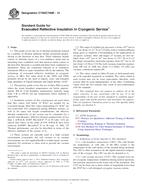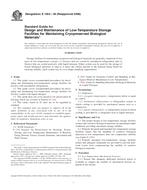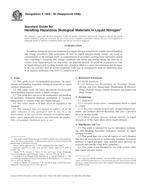Potrebujeme váš súhlas na využitie jednotlivých dát, aby sa vám okrem iného mohli ukazovať informácie týkajúce sa vašich záujmov. Súhlas udelíte kliknutím na tlačidlo „OK“.
ASTM C740/C740M-13
Standard Guide for Evacuated Reflective Insulation In Cryogenic Service
Automaticky preložený názov:
Štandardné Guide evakuovaných Reflexné izolácie Kryogénne
NORMA vydaná dňa 1.11.2013
Informácie o norme:
Označenie normy: ASTM C740/C740M-13
Poznámka: NEPLATNÁ
Dátum vydania normy: 1.11.2013
Kód tovaru: NS-14843
Počet strán: 18
Približná hmotnosť: 54 g (0.12 libier)
Krajina: Americká technická norma
Kategória: Technické normy ASTM
Kategórie - podobné normy:
Anotácia textu normy ASTM C740/C740M-13 :
Keywords:
aluminized films, aluminum foil, cryogenic insulation, cold vacuum pressure, effective thermal conductivity, fiberglass paper, layer density, gas conduction, heat flux, heat transfer, multilayer insulation, polyester film, polyester net, radiation, radiation shields, reflectors, reflective insulation, residual gas, spacers, super insulation, thermal insulation system, thermal performance, vacuum environment, vacuum insulation, vacuum jackets, ICS Number Code 27.200 (Refrigerating technology)
Doplňujúce informácie
| 1. Scope | ||||||
|
1.1 This guide covers the use of thermal insulations formed by a number of thermal radiation shields positioned perpendicular to the direction of heat flow. These radiation shields consist of alternate layers of a low-emittance metal and an insulating layer combined such that metal-to-metal contact in the heat flow direction is avoided and direct heat conduction is minimized. These are commonly referred to as multilayer insulations (MLI) or super insulations (SI) by the industry. The technology of evacuated reflective insulation in cryogenic service, or MLI, first came about in the 1950s and 1960s primarily driven by the need to liquefy, store, and transport large quantities of liquid hydrogen and liquid helium. (1-6)2 1.2 The practice guide covers the use of these MLI systems where the warm boundary temperatures are below approximately 400 K. Cold boundary temperatures typically range from 4 K to 100 K, but any temperature below ambient is applicable. 1.3 Insulation systems of this construction are used when heat flux values well below 10 W/m2 are needed for an evacuated design. Heat flux values approaching 0.1 W/m2 are also achievable. For comparison among different systems, as well as for space and weight considerations, the effective thermal conductivity of the system can be calculated for a specific total thickness. Effective thermal conductivities of less than 1 mW/m-K [0.007 Btu·in/h·ft2·°F or R-value 143] are typical and values on the order of 0.01 mW/m-K have been achieved [0.00007 Btu·in/h·ft2·°F or R-value 14 300]. (7) Thermal performance can also be described in terms of the effective emittance of the system, or Εe. 1.4 These systems are typically used in a high vacuum environment (evacuated), but soft vacuum or no vacuum environments are also applicable.(8) A welded metal vacuum-jacketed (VJ) enclosure is often used to provide the vacuum environment. 1.5 The range of residual gas pressures is from <10-6 torr to 10+3 torr (from <1.33-4 Pa to 133 kPa) with or without different purge gases as required. Corresponding to the applications in cryogenic systems, three sub-ranges of vacuum are also defined: from <10-6 torr to 10-3 torr (from <1.333-4 Pa to 0.133 Pa) [high vacuum/free molecular regime], from 10-2 torr to 10 torr (from 1.33 Pa to 1333 Pa) [soft vacuum, transition regime], from 100 torr to 1000 torr (from 13.3 kPato 133 kPa) [no vacuum, continuum regime].1.6 The values stated in either SI units or inch-pound units are to be regarded separately as standard. The values stated in each system may not be exact equivalents; therefore, each system shall be used independently of the other. Combining values from the two systems may result in non-conformance with the standard. 1.7 This standard does not
purport to address all of the safety concerns, if any, associated
with its use. It is the responsibility of the user of this standard
to establish appropriate safety and health practices and determine
the applicability of regulatory limitations prior to use.
Standard Terminology Relating to Thermal
Insulation Standard Practice for Qualitative
Adhesion Testing of Metallic Coatings Standard Test Methods for Total Normal
Emittance of Surfaces Using Inspection-Meter Techniques |
Podobné normy:
Historická
1.11.2013
Historická
1.6.2013
Historická
1.5.2013
Historická
1.11.2006
Historická
1.11.2006
Historická
1.11.2006



 ASTM C1774-13
ASTM C1774-13 ASTM D6530-00(2013)..
ASTM D6530-00(2013).. ASTM D7863-13
ASTM D7863-13 ASTM E1564-00(2006)..
ASTM E1564-00(2006).. ASTM E1565-00(2006)..
ASTM E1565-00(2006).. ASTM E1566-00(2006)..
ASTM E1566-00(2006)..
 Cookies
Cookies
